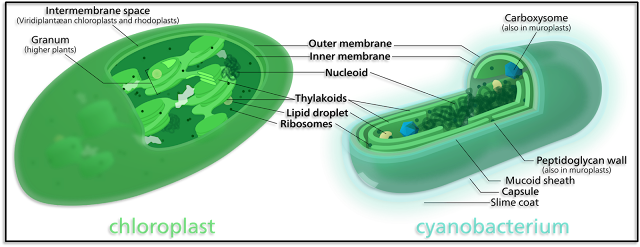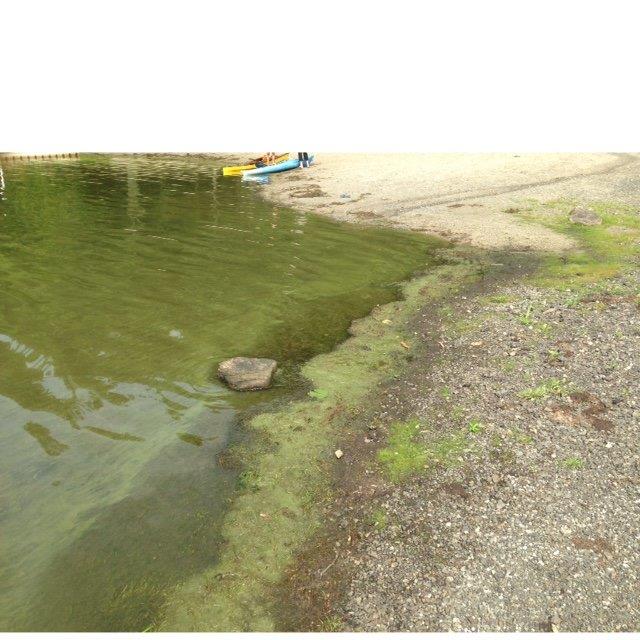Cyanobacteria, FAQs
Cyanobacteria (a.k.a. Blue-green Algae), What is It?
Cyanobacteria are bacteria. They occur naturally in freshwater lakes, rivers, and ponds. Like plants, they use the process of photosynthesis to convert sunlight into food and energy, but with pigments other than green. Unlike plants, the color pigment of cyanobacteria is blue-green and it has other unique properties (Figure 1). Due to these properties it is referred to as "blue-green algae". Typically blue-green algae cannot be seen by the naked eye however, under certain conditions it can grow abundantly and appear as a bloom.
Why are Cyanobacteria toxic?
Cyanobacteria can become toxic in high abundance. Over billions of years, they evolved the process of producing toxins to ward off predators. When cyanobacteria populations become over-abundant the toxins they release can become dangerous to human and animal health. To learn more about health concerns please visit our Health Risks page.
What Causes the Blooms in Bantam Lake?
Blooms usually occur when there is an imbalance of certain factors in the water column. Excess nutrients and warm water temperatures increase the likelihood of blooms. Humans contribute to nutrient loading in the lake by improperly using fertilizers, ineffectively controlling storm-water runoff, and poor septic system maintenance. Bantam Lake also demonstrates an additional nutrient source from the lake bottom sediments. Although Bantam Lake is Connecticut's largest natural lake, it is relatively shallow for its size. This allows the sunlight to reach most of the lake bottom, which mobilizes the nutrients found in the lake sediments, which feeds the cyanobacteria.
How Climate Change Affects these Harmful Blooms
In recent decades, human-induced climate change has been identified as a contributing factor to cyanobacterial blooms. Climate change alters many environmental conditions that contribute to the growth and survival of toxic algae and bacteria. Some conditions include:
Why Does Cyanobacteria Matter?
Cyanobacteria are one of the oldest known organisms to exist on Earth today, dating back to over 2 billion years old. Before cyanobacteria, when earth's atmosphere was very acidic different microbes existed on the planet. These organisms thrived in the absence of oxygen. Roughly 2.4 billion years ago, the earth's atmosphere started to get oxidized and in return, created the 21% oxygen atmosphere we currently inhabit. Cyanobacteria created the atmosphere on earth that supports life as we know it and this life could not exist without cyanobacteria producing a portion of the oxygen that we breath.
Cyanobacteria are bacteria. They occur naturally in freshwater lakes, rivers, and ponds. Like plants, they use the process of photosynthesis to convert sunlight into food and energy, but with pigments other than green. Unlike plants, the color pigment of cyanobacteria is blue-green and it has other unique properties (Figure 1). Due to these properties it is referred to as "blue-green algae". Typically blue-green algae cannot be seen by the naked eye however, under certain conditions it can grow abundantly and appear as a bloom.
 |
| Figure 1. The Difference in Pigment Color of Cyanobacteria vs. Plants (Wikipedia, 2017). |
Why are Cyanobacteria toxic?
Cyanobacteria can become toxic in high abundance. Over billions of years, they evolved the process of producing toxins to ward off predators. When cyanobacteria populations become over-abundant the toxins they release can become dangerous to human and animal health. To learn more about health concerns please visit our Health Risks page.
What Causes the Blooms in Bantam Lake?
Blooms usually occur when there is an imbalance of certain factors in the water column. Excess nutrients and warm water temperatures increase the likelihood of blooms. Humans contribute to nutrient loading in the lake by improperly using fertilizers, ineffectively controlling storm-water runoff, and poor septic system maintenance. Bantam Lake also demonstrates an additional nutrient source from the lake bottom sediments. Although Bantam Lake is Connecticut's largest natural lake, it is relatively shallow for its size. This allows the sunlight to reach most of the lake bottom, which mobilizes the nutrients found in the lake sediments, which feeds the cyanobacteria.
 |
| Factors that Influence Blooms (Lake Champlain Basin Program, 2015). |
What do Blooms look like?
Cyanobacteria blooms frequently appear as a pea-soup green or blue-green color (Figure 2). Coloration may vary depending on the abundance and species preset. Indications of a bloom include increased cloudiness and blue-green pigments throughout the water column, thereby making it hard to see the lake bottom. Cyanobacteria can control where they are in the water column by changing their buoyancy. When certain conditions occur, cyanobacteria will rise up to the water's surface. Wind blowing across the lake's surface concentrates the cyanobacteria in localized areas of the shoreline. These conditions produce a scum on the water's surface that resembles green paint (Figure 3). Thick scums are potentially more toxic due the high concentrations of cyanobacteria and contact should be avoided. To see past blooms please visit our Blooms page. The CT Department of Health uses a visual rationale to assess the risk level of blooms (see Figure 5 on our Health Risks page).
 |
| Figure 2. A Pea-soup Green Cyanobacterial Bloom in Bantam Lake in 2016. |
 |
| Figure 3. A Thick Green Scum on the Surface of Bantam Lake in 2016. |
Seasonal Activity of Cyanobacteria in Bantam Lake
Blooms are most likely to occur in mid to late summer when the water temperature warms up however, cyanobacteria can multiply so rapidly that blooms have been observed as early as April. If water temperatures remain warm enough then blooms can occur as late as November. It is important to be aware of how the lake water is changing throughout the entire year. Keep an eye on the water's clarity and color.
In recent decades, human-induced climate change has been identified as a contributing factor to cyanobacterial blooms. Climate change alters many environmental conditions that contribute to the growth and survival of toxic algae and bacteria. Some conditions include:
- Warmer water temperatures.
- Changes in salinity.
- Acidic rain.
- Changes in precipitation patterns.
- Increased storm events.
For more information please visit:
U.S. Environmental Protection Agency
Additional Sources:
National Climate Assessment
National Climate Assessment
2015 State of the Lake and Ecosystem Indicators Report (Lake Champlain)
Why Does Cyanobacteria Matter?
Cyanobacteria are one of the oldest known organisms to exist on Earth today, dating back to over 2 billion years old. Before cyanobacteria, when earth's atmosphere was very acidic different microbes existed on the planet. These organisms thrived in the absence of oxygen. Roughly 2.4 billion years ago, the earth's atmosphere started to get oxidized and in return, created the 21% oxygen atmosphere we currently inhabit. Cyanobacteria created the atmosphere on earth that supports life as we know it and this life could not exist without cyanobacteria producing a portion of the oxygen that we breath.
Cyanobacterial Evolution During the Precambrian Era (Bettina et al., 2016). Available at: https://www.researchgate.net/publication/296475922_Cyanobacterial_evolution_during_the_Precambrian [accessed May 22, 2017].
Cyanobacteria and the Great Oxidation Event: Evidence from Genes and Fossils (Bettina et al.,2015). Available from: https://www.researchgate.net/publication/279178221_ Cyanobacteria_and_the_Great_Oxidation_Event_Evidence_from_genes_and_fossils
[accessed May 23, 2017].
[accessed May 23, 2017].
 |
| Acidic Atmosphere of Mars vs. Oxidized Atmosphere of Earth (Wikipedia, 2017). |
Bantam Lake Is Not Alone
Cyanobacteria blooms are not just occurring at Bantam Lake. Every U.S. coastal and Great Lakes state experiences harmful blooms. According to the U.S. National Office of Harmful Algal Blooms, harmful inland and freshwater blooms are most widespread in the Great Lakes Region. Blooms have been increasing in Lake Erie since the 1990s. Lake Champlain in Vermont has also been suffering from harmful blooms since the 90s. The State of Vermont is very proactive in dealing with this issue.
Informational Links:


